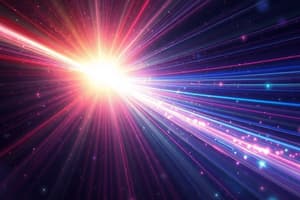Podcast
Questions and Answers
What type of calibration is typically used for objects with flat spectral energy distributions?
What type of calibration is typically used for objects with flat spectral energy distributions?
- AB system (correct)
- Integrated magnitude system
- Vega system
- Zero point system
Who introduced the logarithmic scale equation for magnitudes in astronomy?
Who introduced the logarithmic scale equation for magnitudes in astronomy?
- Johannes Kepler
- Norman Pogson (correct)
- Galileo Galilei
- Isaac Newton
Which factor does magnitude in astronomy depend on, in addition to the physical characteristics of the object?
Which factor does magnitude in astronomy depend on, in addition to the physical characteristics of the object?
- The transmission characteristics of the instrument (correct)
- The object's mass
- The observer's location
- The time of observation
What is the usual magnitude measurement for extended objects like galaxies and nebulae?
What is the usual magnitude measurement for extended objects like galaxies and nebulae?
In which case would a star/galaxy have different magnitudes in different bands?
In which case would a star/galaxy have different magnitudes in different bands?
What did William Herschel discover and measure the temperature of?
What did William Herschel discover and measure the temperature of?
Which type of light was detected first by infrared astronomy in the mid-1800s for quantitative science?
Which type of light was detected first by infrared astronomy in the mid-1800s for quantitative science?
What does Maxwell's Electromagnetic theory state about light in Classical Physics?
What does Maxwell's Electromagnetic theory state about light in Classical Physics?
In Quantum Mechanics, what is light considered as?
In Quantum Mechanics, what is light considered as?
What determines if light exhibits features of a wave or a particle?
What determines if light exhibits features of a wave or a particle?
What is the relationship between the energy of a wave and its wavelength according to Classical Physics?
What is the relationship between the energy of a wave and its wavelength according to Classical Physics?
What is the primary function of the Hubble Guide Star Catalogue?
What is the primary function of the Hubble Guide Star Catalogue?
Which database provides information on an excess of one billion objects down to magnitude 21?
Which database provides information on an excess of one billion objects down to magnitude 21?
What is the purpose of the Naval Observatory Merged Astrometric Dataset (NOMAD)?
What is the purpose of the Naval Observatory Merged Astrometric Dataset (NOMAD)?
Which telescope was used for the very large and deep sky survey conducted by the Sloan Foundation?
Which telescope was used for the very large and deep sky survey conducted by the Sloan Foundation?
What is the main feature of the USNO A2.0 database?
What is the main feature of the USNO A2.0 database?
What did Heinrich Hertz study in the late 1800s?
What did Heinrich Hertz study in the late 1800s?
In which regime do UV to IR observers refer to electromagnetic waves?
In which regime do UV to IR observers refer to electromagnetic waves?
Which community referred to different bands depending on their research?
Which community referred to different bands depending on their research?
What late 1800s scientist is known for proposing that light is quantized into discrete packets called photons?
What late 1800s scientist is known for proposing that light is quantized into discrete packets called photons?
What type of emission does the Sun exhibit primarily, despite being expected to show continuous emission?
What type of emission does the Sun exhibit primarily, despite being expected to show continuous emission?
Which property of electrons is quantized according to the quantum theory mentioned in the text?
Which property of electrons is quantized according to the quantum theory mentioned in the text?
What is the primary purpose of the Johnson-Morgan or UBV photometric system mentioned in the text?
What is the primary purpose of the Johnson-Morgan or UBV photometric system mentioned in the text?
What do negative values in the context of star magnitudes indicate?
What do negative values in the context of star magnitudes indicate?
Which photometric system is described as the most commonly adopted standardized system developed in 1953?
Which photometric system is described as the most commonly adopted standardized system developed in 1953?
What is the main purpose of celestial color indices as defined in the text?
What is the main purpose of celestial color indices as defined in the text?
In observational astronomy, what is considered the global coordinate system where any star has the same coordinates for all observations on Earth?
In observational astronomy, what is considered the global coordinate system where any star has the same coordinates for all observations on Earth?
What is typically used to specify a location on Earth in terms of degrees, minutes, and seconds as described in the text?
What is typically used to specify a location on Earth in terms of degrees, minutes, and seconds as described in the text?
What error type originates from mistakes or blunders in measurements or computations according to the text?
What error type originates from mistakes or blunders in measurements or computations according to the text?
Which term best describes the difference between observed/calculated value and true value in measurements?
Which term best describes the difference between observed/calculated value and true value in measurements?
'Fluctuations in readings' due to systematic errors in measurement are categorized under which type of error analysis?
'Fluctuations in readings' due to systematic errors in measurement are categorized under which type of error analysis?
Which catalog utilized Greek letters and constellation names for identifying bright stars, as mentioned in the text?
Which catalog utilized Greek letters and constellation names for identifying bright stars, as mentioned in the text?




